
The Mercedes-Benz 450SEL 6.9 is the high-performance version of the W116 S-Class saloon. It was based on the long-wheelbase version of W116 chassis introduced in 1972 and equipped with Mercedes-Benz M100 V8 engine and full hydropneumatic suspension system. The 450SEL 6.9 was presented to the public at the Geneva Auto Show in 1974 as the successor to the original high-performance saloon from Mercedes-Benz, the 300SEL 6.3 (1968–1972). Like the 300SEL 6.3 before it, the special displacement number (6.9) was affixed to the trunk lid to differentiate itself from the 450SEL. The 450SEL 6.9 was produced in very limited numbers from 1975 to 1980.

The Jaguar AJ-8 is a compact DOHC V8 piston engine used in many Jaguar vehicles. It was the fourth new engine type in the history of the company. It was an in house design with work beginning before Ford's purchase of the company. In 1997 it replaced both designs previously available on Jaguar cars: the straight-6 Jaguar AJ6 engine, and the Jaguar V12 engine. It remained the only engine type available on Jaguar until 1999 with the launch of the S-Type, when the Jaguar AJ-V6 engine was added to the list. The AJ-V8 is available in displacements ranging from 3.2L to 5.0L, and a supercharged version is also produced. Ford Motor Company also used this engine in other cars, including the Lincoln LS and the 2002–2005 Ford Thunderbird, as well as in several Land Rovers, and the Aston Martin V8 Vantage.

The VQ is a family of V6 automobile petrol engines developed by Nissan and produced in displacements varying from 2.0 L to 4.0 L. Designed to replace the VG series, the all-aluminium 4-valve per cylinder DOHC design debuted with Nissan's EGI/ECCS sequential multi-point fuel injection (MPFI) system. Changes from the VG engine include switching to a timing chain from a timing belt, and relocating the water pump from the outside of the engine to inside the timing cover where the pump is driven by the timing chain. Later versions featured various improvements, such as variable valve timing, and NEO-Di designated VQ engines replace MPFI with direct fuel injection.

The Toyota R family was a series of inline-four gasoline automobile engines. Designed for longitudinal placement in such vehicles as the Celica and Hilux and in production from 1953 through 1997, usage faded out as many of Toyota's mainstream models moved to front-wheel drive. Overhead cam (OHC) versions featured a chain-driven camshaft.

The Mercedes-Benz M113 engine is a gasoline-fueled, spark-ignition internal-combustion V8 automobile engine family used in the 2000s. It is based on the similar M112 V6 introduced in 1997, then later phased out in 2007 for the M156 AMG engine and the M273 engine.

The Mercedes-Benz R107 and C107 are sports cars which were produced by Mercedes-Benz from 1971 until 1989, being the second longest single series ever produced by the automaker after the G-Class. They were sold under the SL (R107) and SLC (C107) model names in a variety of names indicating the displacement of the engines.

The M110 engine family is a DOHC crossflow cylinder head design with 2 valves per cylinder straight-6 automobile engine made by Mercedes-Benz in the 1970s and 1980s.

The Mercedes-Benz W126 is a series of passenger cars made by Daimler-Benz AG. It was marketed as the second generation of the Mercedes-Benz S-Class, and manufactured in sedan/saloon (1979–1991) as well as coupé (1981–1990) models, succeeding the company's W116 range. Mercedes-Benz introduced the 2-door C126 coupé model, marketed as the SEC, in September 1981. This generation was the first S-Class to have separate chassis codes for standard and long wheelbases and for coupé (C126).
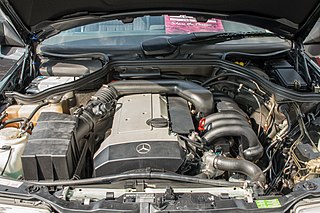
The Mercedes-Benz M104 is a automobile straight-six engine produced from 1988 through 1999. It has a double overhead cam design with 4 valves per cylinder, and used a crossflow cylinder head. It replaced the M103 and was replaced by the M112 V6 starting in 1997. The bore spacing on all M104 engines is the same as M103 engines.

The Mercedes-Benz M119 is a V8 automobile petrol engine produced from 1989 through 1999. It was available in 4.2 L; 5.0 L; and 6.0 L displacements. It was a double overhead cam design with 4 valves per cylinder and variable valve timing on the intake side. It was replaced by the 3-valve M113 starting in 1997.
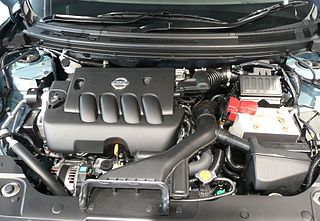
The Renault-Nissan MR engine family consists of straight-four 16-valve all-aluminium and water cooled automobile engines with variable valve timing co-developed by Renault and Nissan. Renault calls it the M engine. Other noteworthy features of this engine family include acoustically equal runner lengths and a tumble control valve for the intake manifold, a "silent" timing chain, mirror finished crankshaft and camshaft journals, and offset cylinder placement in an attempt for increased efficiency.

The Honda R engine is an inline-four engine launched in 2006 for the Honda Civic (non-Si). It is fuel injected, has an aluminum-alloy cylinder block and cylinder head, is a SOHC 16-valve design and utilizes Honda's i-VTEC system. The R series engine has a compression ratio of 10.5:1, features a "drive by wire" throttle system which is computer controlled to reduce pumping losses and create a smooth torque curve.

The Mitsubishi 4A9 engine is the newest family range of all-alloy inline four-cylinder engines from Mitsubishi Motors, introduced in the 2004 version of their Mitsubishi Colt supermini, and built by DaimlerChrysler-owned MDC Power in Germany.

The Mercedes-Benz M273 engine is a V8 automobile piston engine family used in the 2000s (decade). It was based on the similar M272 V6 introduced in 2004.
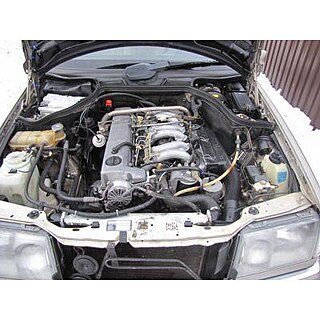
The OM603 engine was a straight-6 Diesel automobile engine from Mercedes-Benz used from 1984 through 1999. The 603 saw limited use in the W124, W126 and W140 model vehicles.
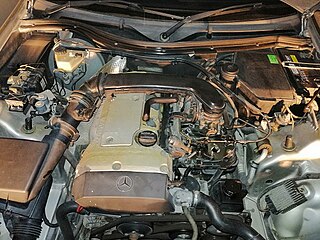
The M111 engine family is a straight-4 automobile engine from Mercedes-Benz, produced from 1992 to 2003. Debuted in the 1992 Mercedes-Benz E-Class (W124), this engine family is relatively oversquare and uses 4 valves per cylinder. All engines in the family use a cast iron engine block and aluminum alloy cylinder head.

The E0 series is a three-cylinder gasoline engine developed and manufactured by Honda, with a total displacement of 656 cc. The engine is intended for kei car applications. The E05A and E07A were partially replaced by the Honda P engine but as of 2020 the E07Z engine still saw use in the Acty truck.
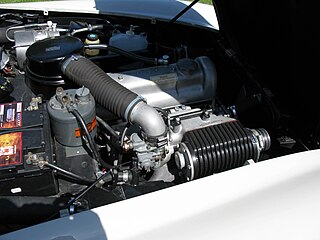
The Mercedes-Benz M121 engine was a 1.9 liter single overhead camshaft inline four-cylinder engine introduced by Mercedes in 1955 and used in various model lines during the 1950s and 1960s. Originally rated at 56 kW at 5500 rpm, it replaced the 1.8 liter M136 introduced in 1935, offering improved performance over the M136's side camshaft design.
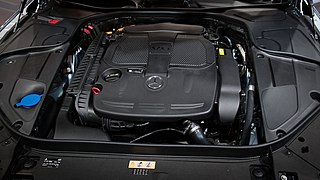
The Mercedes-Benz M276 engine is a direct injected, gasoline automotive piston V6 engine.

The M176/M177/M178 is a petrol V8 engine range designed by Mercedes-AMG, replacing the M278 and M157 engines, and is based on the M133 engine.




















